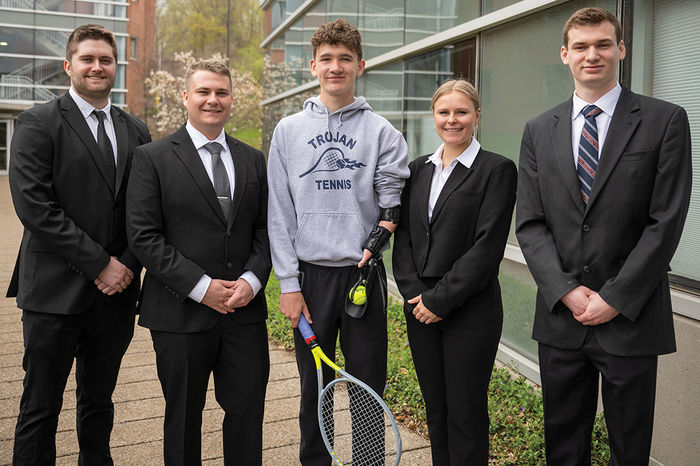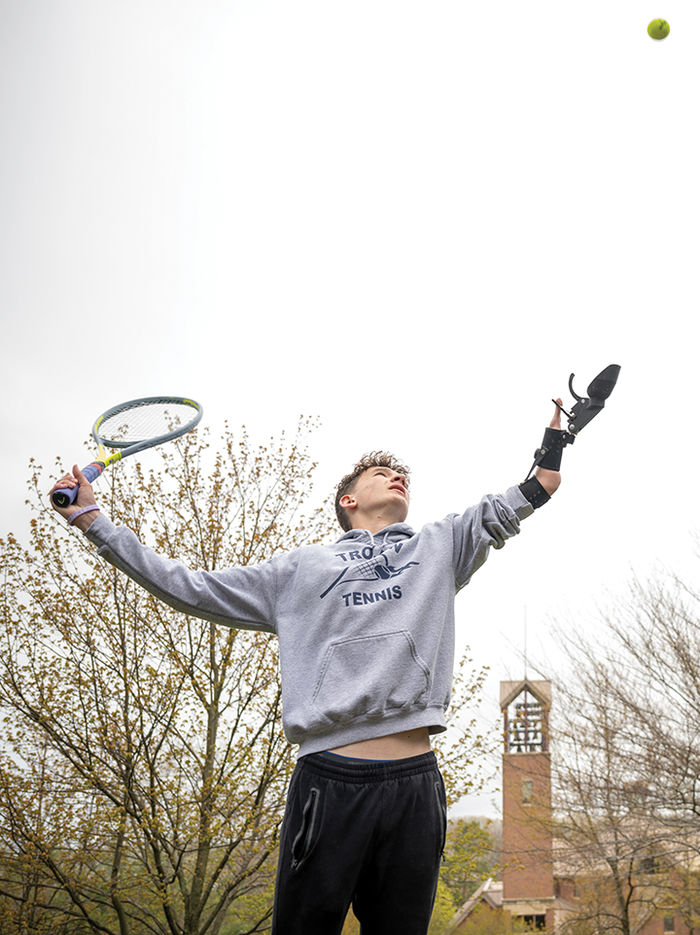Design team creates prosthesis for tennis player
Christian Neubert, 16, a sophomore at Erie’s McDowell High School, was born without a left hand. It’s a challenge he learned to live with long ago, and it hasn’t held him back. Overcoming and adapting to it is something he said he almost relishes at this point. Enter tennis.
In middle school, he decided to try the sport. He enjoyed it, so he took lessons, and when he entered high school, he joined the boy’s team. He learned to play well one-handed, but serving was difficult. He had to tuck the racket under his arm, toss the ball unusually high and then grab his racket with the same hand to hit it. His coach suggested a prosthesis.
Christian and his parents worked with Shriner’s Hospital for Children in Erie, where he chose a prosthesis that had been designed for pitching a baseball.
Within a few months, he had improved enough to earn a starting spot in doubles play. But he was still struggling with his serve; the prosthesis was heavy and unreliable in releasing the ball.
When Dean Lewis, assistant teaching professor of mechanical engineering, read a newspaper story about Christian, he knew that Behrend engineering students could help.
Like Christian, they relish challenges.
Challenge Accepted
Lewis reached out to the Neubert family through a mutual friend, and a new senior design capstone project was added to the list that teams of seniors could pick from.
One group of Mechanical Engineering majors—Maxwell Myers, Deven Phillips, Morgan Tarbrake, and Zachary Vandervort—made it their No. 1 choice.
“When we got the list of capstone projects, I said, ‘This is the one we have to do,’” said Tarbrake, who was minoring in Biomedical Engineering. “This project gave us a chance to actually help someone.”
Christian’s mother, Amy, said the Neuberts were equally happy about the opportunity. “We were so excited,” she said. “Christian
was making do with what he had, but this was a chance to have a tennis-specific prosthesis made especially for him.”
Step one for the team was to get the lay of the land—meet Christian, see the current prosthesis, find out what needed to be improved, and research what tennis prostheses might already be available.
“We found prosthetics for skiing, bicycling, swimming, and almost every sport but tennis,” Myers said.
They weren’t quite starting from scratch, however, as a portion of Christian’s current prosthesis—the part that attaches to his arm—could be used. “We determined pretty quickly that we could use a threaded adapter to attach a new device to the existing human interface,” Myers said.
Many Metrics to Meet
With one problem solved, there were still many metrics to meet. The device they built had to be lighter, affordable (less than $2,500), compliant with PIAA tennis guidelines, comfortable, safe, easily cleaned, secure-fitting, consistent, reliable, durable, easily maintained, and easily worn and adjusted with one arm.
That list might seem overwhelming, but the team did what engineers do: broke it into a series of steps and began methodically working toward the goal of creating a comfortable, lightweight prosthesis that could precisely hold and serve a tennis ball.
The student team came up with several concepts before settling on a cup design with a finger release latch. Once they had a product, they went through many rounds of prototyping and testing with Christian.
“We met with him almost weekly to test and get feedback,” Phillips said. “It was a very iterative process. Along the way, Christian was able to build up some practice using it and develop a certain skill level with it.”
Mission Accomplished
Christian is excited to begin working with the final product, which the team finished in late April.
“This prosthesis is much lighter,” he said. “Also, since there is a way to secure the ball (with the finger latch), it will help me control my release better and throw higher, which will help make my serve more powerful.”
There will be a learning curve, but Christian is up for the challenge, of course.
“It will definitely take some getting used to, as I will have to train myself to release the ball at a much different place.”
A Project With Impact
“It was a fulfilling project,” Tarbrake said. “I can’t tell you how many times I told my teammates, ‘Guys, I’m going to cry’ because it was so emotional to be able to help someone and see the results.”
The project inspired Tarbrake to continue working toward a Biomedical Engineering minor. “I was just going to let it go because it’s more work, but after I got involved in this, I knew I had to finish it,” she said.
Christian, whose father, Dan, is a chef at Penn State Behrend in Dobbins Dining Hall, plans to attend Penn State to pursue degrees in Computer Science and Business.
The four student team members graduated from Behrend in May. At the time of their graduation, each of them had accepted positions in various sectors, including transportation, quality control, and nuclear energy.

